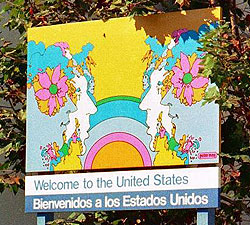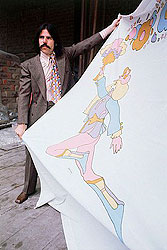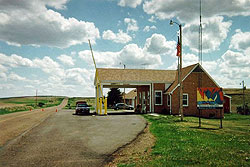The year was 1976 and the U.S. was turning 200. Bicentennial celebrations and observations were taking place around the country. American pop artist Peter Max had just fulfilled a government-commissioned bicentennial project-the creation of seven paintings to be reproduced as 200 new bilingual border welcome signs for the U.S. General Services Administration.

cloud-like silhouettes is one of seven
designs Max created for GSA's border
mural project. San Ysidro, Calif., port
of entry, approx. 1980.
The commission called for the signs to stand for 20 years. Estimates projected that 5.5 billion people would pass by and see the signs. Yet it would be several years before Max's designs would be seen by anyone entering the U.S. The project had been sidelined, and Peter Max's welcome signs had become unwelcome.
Internal wrangling over Max's artistic style kept the new signage veiled in GSA's offices, halls and warehouses for nearly three years. Images of winged creatures, abstract flowers and starry skies seen in Max's prints were rumored to be "too psychedelic" by officials within GSA and the U.S. Customs Service, under whose jurisdiction the signage was to be placed. Vernon Darrell Acree, then commissioner of Customs, considered the signs "inappropriate," believing they "presented a poor first impression to people coming to the United States" and contrary to the agency's platform on drug control.
Bemused by the reaction to his designs, Max called the criticism "not-valid."
"These are done in my style, which is different, but they're certainly not psychedelic," said Max. By Max's account the purpose of the art was to "represent my view of the futuristic and contemporary feelings of America today, and to greet foreigners or returning Americans with these visions."

displaying his signature style
of cosmic characters in New
York City, 1970. Copyright
Bettmann/CORBIS
Max said the illustrations "were designed especially to welcome people in outdoor spaces and give them an immediate glimpse of this fantastic America we're in. I don't think they will be as appropriate indoors."
With time came change. In 1977 the U.S. saw a shift in administration and an advocate for Peter Max's work-President Jimmy Carter. With the President's backing, GSA's new administrator, Jay Solomon, sought to revive the bicentennial signage project. Solomon initiated a pilot project in an effort to gain the support of both Customs and the Immigration and Naturalization Service.
On Sept. 29, 1977, two of Max's designs bearing the message "Welcome to the United States" in French and English, were erected at Alexandria Bay, N.Y., and Highgate Springs, Vt. Signs were concurrently placed on easels and displayed at Customs headquarters in Washington, D.C. The artwork was well received in each location according to an informal GSA survey. At the border, the GSA official monitoring the public reaction to Max's signs recalled crossers jumping out of their cars to take pictures.
On July 4, 1978, President Carter held a dedication ceremony at the White House for America's new welcome signs. In attendance were representatives from the two countries the bilingual signs would face-Canadian Ambassador Peter Towe and Mexican Ambassador Hugo Margain. Simultaneous celebrations were held at the U.S. embassies in Ottawa, Mexico City and the approximately 160 ports of entry where Max's signs were placed.

once featured at the Whitetail, Mont., port
of entry. Courtesy U.S. DOT Volpe Center.
Peter Max's artistic presence at the border, however, was short-lived. A 1984 survey of the signs by the Customs Service found them to be in "deplorable conditions." They were faded, most were destroyed by weather, snow plows and vehicles, and some were riddled with bullet holes or missing altogether. Over time, the Max welcome markers were replaced with more conventional signage.
Peter Max (b. Peter Max Finkelstein, 1937) is a German-born Jewish American pop artist, illustrator, and muralist. Max, born in Berlin, was raised in Shanghai, Tibet, South Africa, France, and Israel before emigrating to Brooklyn, N.Y., in 1953. Max came to prominence in the mid 1960's by pioneering the use of photographic images and kaleidoscopic patterns in collages. Since America's bicentennial in 1976 Max has created a painting of the Statue of Liberty annually. Max has also painted for six U.S. presidents, designed the first environmental U.S. postage stamp, and served as an artist for the World Cup USA, Super Bowl, Olympics, Rock and Roll Hall of Fame, Woodstock 1994 and 1997, among many other projects. His work can be seen in collections across America, including presidential libraries, U.S. embassies, and major museums.
Do you have a photo of Peter Max's welcome signs? Or remember their placement along our borders and want to tell us your story?
Contact the CBP History Program at CBPhistory@dhs.gov.


